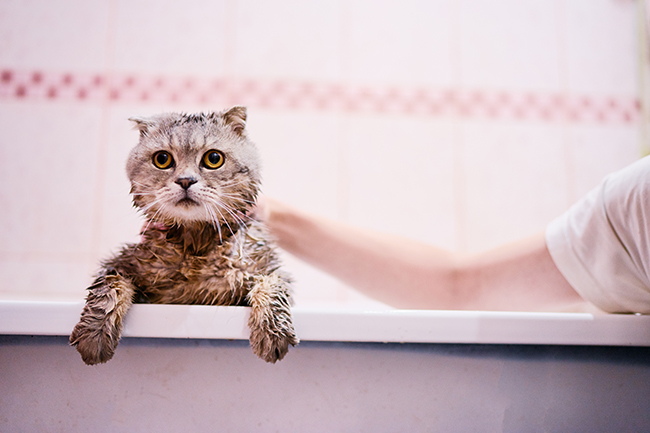How to help your felines stay clean without causing harm to them—or you.
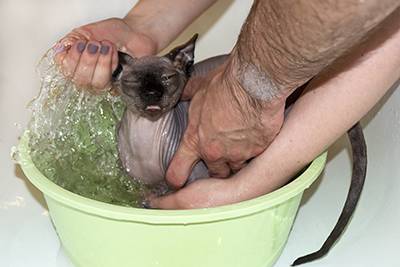
©Elena/Adobe Stock
The reality of being an ailurophile is that sometimes you have to bathe your cat; and the hard truth is that most felines don’t like being in water. That fact alone should give you real respect for pet groomers!
For the most part, cats are pretty good at keeping themselves neat and tidy. Being super flexible, they can reach almost any spot, and don’t like to be covered in dirt or grease. However, they will occasionally get into something that even they can’t handle. Here are few reasons why you might need to help your cat out, along with how to do so without causing too much stress to either of you.
-
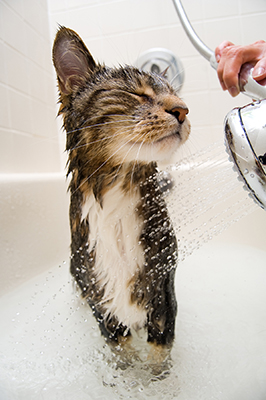
Some cats actually enjoy, or at least tolerate, getting wet.
©Michael Pettigrew/Adobe StockHairless cats require quite a lot of grooming because their skin continues to emit oils that invariably attracts dirt. This dirt sticks to the body and can attract other unwanted things, such as bacteria. The ears and “bum” area need to be frequently cleaned, as do the eyes. If you have a hairless cat, it’s important to get him accustomed to baths early on in her life.
- Your 12-year old cat is finally slowing down. She’s not jumping as high, walking as much, hunting as often, or cleaning himself as well as she used to do. You will most likely need to help him through her golden years with frequent brushing, regular nail clipping and occasional bathing.
- A bath can help resolve a flea infestation. A warm bath with regular cat shampoo can help suffocate and remove fleas from your cat’s body safely. If you opt to you use a flea shampoo, make sure it is cat-specific as some dog shampoos could cause serious harm.
- Occasionally your cat might get into something she cannot or should not lick off. This is true of car grease/oil and other leaked vehicle fluids.
Decide on a Location
You might want to use either a sink or a bathtub, depending on the size of your cat and her tolerance for water. Sinks can be easier on your back; however, if you have larger cats (as I do), you’ll want to choose the tub. A large plastic tub (e.g., a foot bath or wash basin) placed inside abathtub or on a tile floor is another option.
Gather Supplies
Have all the bathing supplies within easy reach before you pick up your cat and put her in the tub or sink. You will need:
-
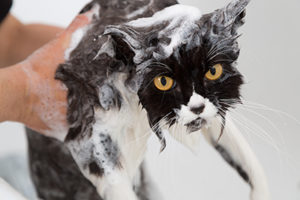
Work as quickly as possible when bathing your feline—and always use a cat-specific shampoo.
©135pixels/Adobe StockCat Shampoo: choose a shampoo that is specifically formulated for cats’ skin and coat. I love the Feline Shampoo bar from DERMagic because it enables me to use one hand for cleaning rather than two for handling the bottle, holding the cat, etc. No matter which shampoo you select, please be certain it’s formulated for cats.
- Large pitcher or bowl for rinsing: Have a container of clean water for rinsing. I dip a giant plastic cup into a bucket of clean water for easy rinses. A hand-held shower or spray nozzle works well, too.
- Towels: The faster you can get your feline secured and into the safety of a warm towel, the happier you both will be. I like to spritz the cat towel with a little Feliway, which helps calm them. You will also need a towel for the bottom of the sink or towel.
- Soft washcloth for the face and ears
Prepare the Bath
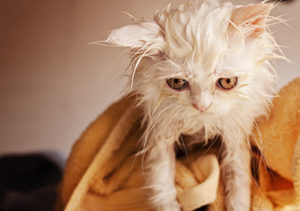
©otosmile777/Adobe Stock
The key to a successful bath is to have the water as close to your cat’s natural body temperature as possible. That way, she should be more “accepting” of being wet. Place one of the towels in the water along the bottom of the tub or sink. This gives your cat something to grab onto and will help her feel more secure. The water level should only be about 3 or 4 inches, coming up to your pet’s belly and no higher.
Close off the Area
Make sure you are working in an area that is confined. The bathroom is an ideal place. If your cat begins to freak out, you need to let her go. Take your time before you approach her; she will need to calm down before you try again.
Prepare Your Cat
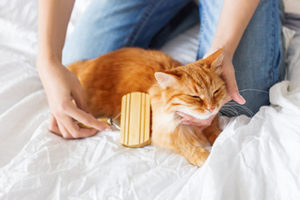
©Konstantin Aksenov/Adobe Stock
Brush your cat before bathing her, particularly if she has long hair and/or tangles. Mats are much more difficult to remove when they’re wet. This is also a great time to clip your cat’s nails, which can help you avoid a deep claw marks if/when your cat flips out. Talk to your cat, give her treats or bring her favorite toy in to help her relax. Catnip can also help some cats relax beforehand.
Make sure you play with your cat and do your best to tire her out before a bath. This helps make the bath a calmer experience for all.
Work Quickly
Gently wet your cat’s fur and begin to massage in the shampoo. This is when the shampoo bars come in handy because you can use one hand to control your pet while you use the other to shampoo them. If you don’t use shampoo bars, you may want to enlist the help of a friend. Bathing a cat is a two-person job if they aren’t accustomed to it.
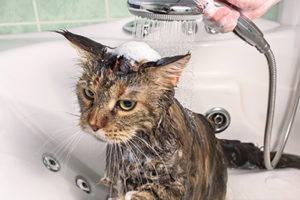
©ollegn/Adobe Stock
Use a washcloth to gently clean her face and ears. Don’t forget to pay close attention to her rear and underbelly. Rinse your cat completely; this is an important part of the process as left-in shampoo can dry the skin and cause irritation or cause her to throw up if she licks it off.
Make drying a fun experience. Lift your cat into a thick, warm towel and tell her what a good girl she is. Towel dry her as much as possible and then let her roam the enclosed area a bit while your brush out her fur.
Baths can be a great experience for cats if they are introduced to the process early on. However, even senior cats who have never been bathed can learn to appreciate them. The key to a cat bath is to remain calm, keep your cat as relaxed as possible and treat the experience as a new game. Most cats can become at least accustomed to baths.



